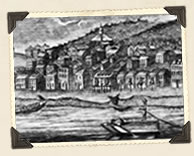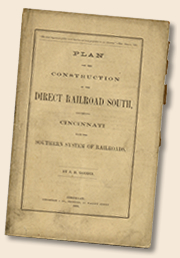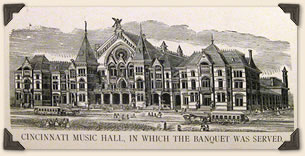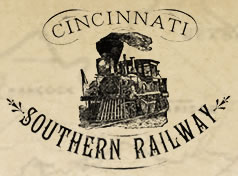 The idea of a railroad through Cincinnati was hardly new when the first passenger train completed the 337 mile journey on March 8, 1880. Nor was it revolutionary when the legislation that paved the way for the railroad, the Ferguson Act, passed on May 4, 1869. In fact, the first public meeting in Cincinnati to consider railway transportation and cities of the South was held in 1835. In 1836, Cincinnati sent a delegation to the Great Southwestern Railroad Convention conceived by John C. Calhoun. It was agreed upon at the convention that Cincinnati showed great promise for a railroad project. But the financial crash of 1837 derailed the project.
The idea of a railroad through Cincinnati was hardly new when the first passenger train completed the 337 mile journey on March 8, 1880. Nor was it revolutionary when the legislation that paved the way for the railroad, the Ferguson Act, passed on May 4, 1869. In fact, the first public meeting in Cincinnati to consider railway transportation and cities of the South was held in 1835. In 1836, Cincinnati sent a delegation to the Great Southwestern Railroad Convention conceived by John C. Calhoun. It was agreed upon at the convention that Cincinnati showed great promise for a railroad project. But the financial crash of 1837 derailed the project.
Though the project never got off the ground, chatter about building a railway did not fade. In 1859, a second attempt was made, but that project was also abandoned when the Civil War intervened. At one point, the Civil War itself presented an opportunity for establishing a railroad for military transport, but other war matters overshadowed the proposition and it too was abandoned.
At the close of the Civil War, rail was developing rapidly, but lines ran primarily East to Northwest. Cincinnati recognized not only the need to link the natural resources of the South to the industrializing Midwest, but also the underserved post-war market it had unique positioning to reach. With that, the Cincinnati Southern Railway was born.
 Although significant support for the railroad existed, there was also a significant hurdle. In 1851, the Ohio Constitution was changed to prohibit cities from becoming owners in any joint stock company, effectively preventing Cincinnati from constructing its railway. To overcome this obstacle, the father of the Cincinnati Southern Railway, Edward A. Ferguson, put forth a "remarkable proposition." Mr. Ferguson proposed that if the city could not aid a private enterprise in building the railroad, the city itself should build and own the road.
Although significant support for the railroad existed, there was also a significant hurdle. In 1851, the Ohio Constitution was changed to prohibit cities from becoming owners in any joint stock company, effectively preventing Cincinnati from constructing its railway. To overcome this obstacle, the father of the Cincinnati Southern Railway, Edward A. Ferguson, put forth a "remarkable proposition." Mr. Ferguson proposed that if the city could not aid a private enterprise in building the railroad, the city itself should build and own the road.
Mr. Ferguson’s proposition was passed May 4, 1869 and the citizens of Cincinnati voted in overwhelming support of the railway on June 26, 1869. Charles G. Hall recounted the election in his 1902 history of the Cincinnati Southern Railroad, "The day was made a holiday. Nine bands of music paraded the streets. The fire bells rang at six in the morning, at noon, at three in the afternoon. Various wards organized. A full vote was urged."
 It was not until 1880 – almost eleven years after the Ferguson Act was approved by the Cincinnati citizenry – that the first trains would complete the journey from Cincinnati to Chattanooga. While trains had run on the finished portion since the summer of 1877, it was February 21, 1880 that the first freight train rode the entire line, and March 8, 1880 that the first passenger train completed the 337 mile trip.
It was not until 1880 – almost eleven years after the Ferguson Act was approved by the Cincinnati citizenry – that the first trains would complete the journey from Cincinnati to Chattanooga. While trains had run on the finished portion since the summer of 1877, it was February 21, 1880 that the first freight train rode the entire line, and March 8, 1880 that the first passenger train completed the 337 mile trip.
The completion of the Cincinnati Southern Railroad was commemorated by a grand banquet at Music Hall on March 18, 1880. Trainloads of southern dignitaries were brought in for the celebration that was described in January 17, 1880 edition of the Cincinnati Enquirer as "a grand banquet, surpassing any thing ever known on the continent."
Cincinnati still owns the Cincinnati Southern
Railway and leases its use to Cincinnati,
New Orleans and Texas Pacific Railway
(CNO&TP), a wholly-owned subsidiary
of Norfolk Southern. While CNO&TP
handles most of the line’s maintenance
needs,
a major overhaul or the road was done
in 1961
to modernize the track and tunnels.
In 1987, the City renegotiated the terms of the lease for more favorable annual income. From 2003 to 2008, the Southern Railway Note Proceeds totaled $95.5 million.
In accordance with a recommendation in the Smale Commission report, the City Council endorsed a policy by resolution to dedicate funds generated by the Southern Railway to infrastructure projects. The income from the railroad today provides a resource for infrastructure projects.

